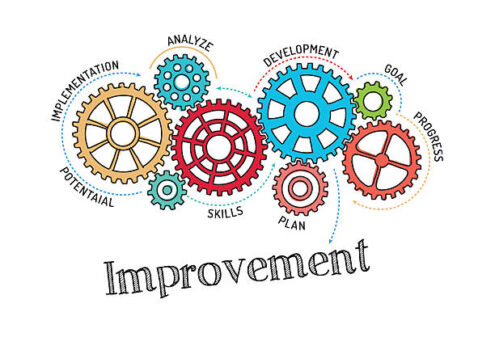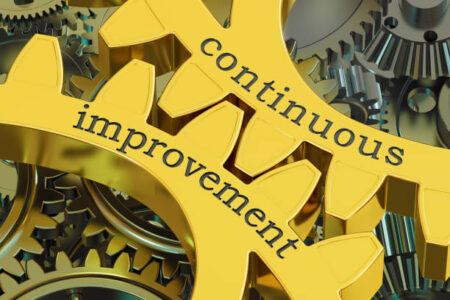Introduction
The term continual improvement covers the aspect of bringing enhancement in the products, services or processes involved either through incremental or breakthrough upgrades.
Bringing improvements in the product through recurring activities hikes the ability of the product to fulfil the laid down requirements. While the continual improvement can be achieved by various tools like – utilization of quality policy, quality objective, audit outcomes, data analysis, preventive actions in case of deviations and management review adopted. Not only management is entrusted with the responsibility of continual improvement but the whole organisation must know the results of the improvements and how to get it measured.
The concept has posed a new challenge for the management and staff but if realized properly then it could lead towards achievement of goals with optimal resource allocation. It even leads towards evaluation of optimal functionality of all the processes thereby increasing the efficiency.
Difference between continual improvement and continuous improvement?
Continual Improvement is a concept which is related to bringing changes and improvements in the existing system to generate better outcomes. While continuous improvement is a subcategory of continual improvement or a linking chain which aims at bringing small improvements in the processes within a system.
While these terms are used interchangeably but the continual improvement will have a phased process of system where enhancements would be made then there would be a halt to measure and analyse the success, then moving further to bring positive changes.
But the continuous improvements flows uninterrupted as it would continuously cater towards making improvements, being a sustained development process.
Elements of continual improvement
It align the organization practices and services with the dynamic business needs by bringing improvements in products, services and practices. The elements involved in the process includes:
Planning– the continual improvements approach significantly apply to planning activity, methodology and techniques to see whether organization’s current objective and context perfectly aligns with the improvements proposed.
Bringing improvements– as a value chain activity structure resources and activities which carry along the improvements not only in departments but also for the overall firm.
Engage, designing, obtain/ build – the continual improvement practices stays relevant to the firm.
Scope of continual improvement
It involves the development of enhancement related methods and unique techniques.
Spreading of continual improvement culture within the organisation and align it with the organization’s set strategy.
The commitment to continual improvement must be injected in the blood of every person and department within the organisation, which will reduce the risk in daily operational activities.
What key activities can be inculcated as continual improvement practices?
• Motivating the organization to adapt continual improvement.
• Preparing budget and setting time for the continual improvement process.
• Identifying and availing the improvement opportunities.
• Analyzing and prioritizing the improvement activities.
• Developing business situations for bringing improvement action.
• Planning and applying improvements
• Adequate measurement of improvement outcomes
• Evaluating and synchronizing improvement activities while implementing in the organization.
Role of continual improvement
Continual Improvement stands as one of the essential principle in quality management and aims at achieving core goal of an organization. The major objective of any organisation must be ‘continual improvement’ due to its benefits of performance that comes from improved organisation proficient abilities. When the improvement strategies at all levels get aligned with flexibility and stragised short term goals will enable them to react to opportunities promptly.
Steps to continual improvement process as quality management principle
• Continual improvement serves as an ultimate objective for the entire organisation down the hierarchy from top to bottom level and need to be implemented along various product lines, processes and systems embedded within the organisation.
• The basic assumption of step to step and breakthrough improvements are well carried out throughout the organisation.
• Utilizing the technique of continuous evaluation and assessments against the set bar of targets which would help detect the area of improvement, following the part of quality management strategy along with.
• Bringing enhancements in the proficiency and efficiency of all the procedural activities by ensuring that there is always a room of improvement adapting the fluid rather than static approach, which means adapting no new processes but working with outdated processes.
• Need to develop an approach where the problems could be resolved through prevention based actions rather than only reacting to the problem which makes them harder to manage.
• Enlightening the employees with the various tools of continual improvement Plan-do-check Act cycle, process re-engineering and innovation through education and training.
• Using the principles of management of reporting and monitoring helps in establishing the measures and goals to bring success in the potential areas through processes in the organisation.
• Then improvements so recognized are made applicable among all levels of the organisation to reflect the results obtained through continual improvement strategies and further encouraging motivation for long term perspectives.
Continual Improvement model
Planning– this step involves identifying the opportunities and determining the improved plan of action. Plan is developed by brainstorming ideas, identifying explaining the opportunities and then finally developing plans.
Do/ performing– to check the feasibility it is implemented on a smaller scale with many possible solutions.
Scrutinizing– this stage is linked with comparing expected performance with achieved performance if not achieved then need to start it again.
Implementing the solution– which is achieved with improvement.
Advantages of continual improvement
• Enhancing the morale of employees
• Bringing ultimate customer satisfaction
• Customer services improvement
• Lessen the lead time of processes
• Enhancing employees engagement
• Staff turnover reduction with less money spent on labour
• Proactive learning platform
• Quick response and shipments in the market
• Better hand over inventory and maximizing profit ratio sharing
• Emerging competitive production
Conclusion– The only way to maintain and sustain a continuous improvement culture is to target towards developing new and better competencies. By the application of principle of continuous improvement, organization can pose a challenge against employees to motivate them to enhance their skills and knowledge. This would enable a company to stay ahead of their competitors. By building skillsets of team members it would lead avoiding technical debts in a project and would also lead to making dividend payments down the line. Whenever any employee learn new solutions to the problems and share their findings, the whole organisation gets benefitted. As teams will be effectively working to maintain their knowledge base and implement new strategies they are able to beat the guidelines and close feature gaps.


